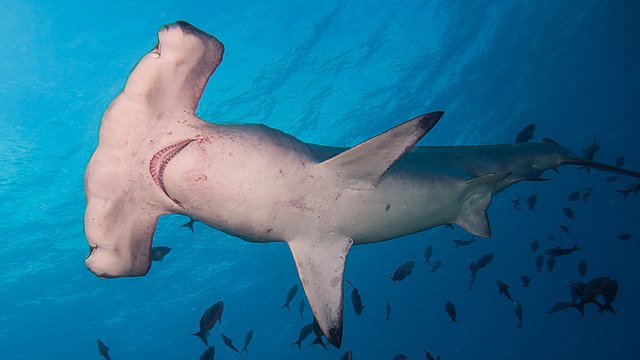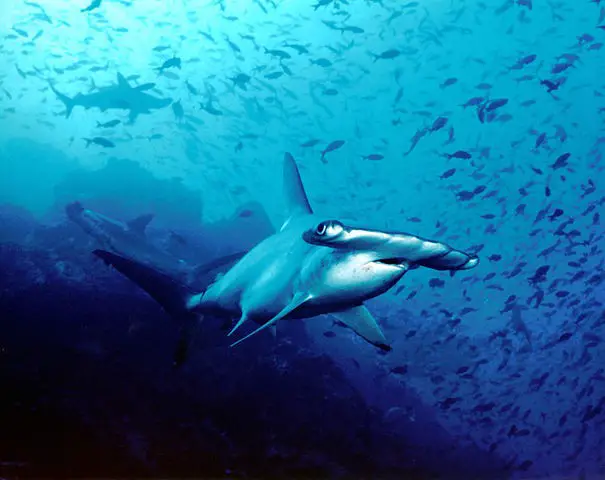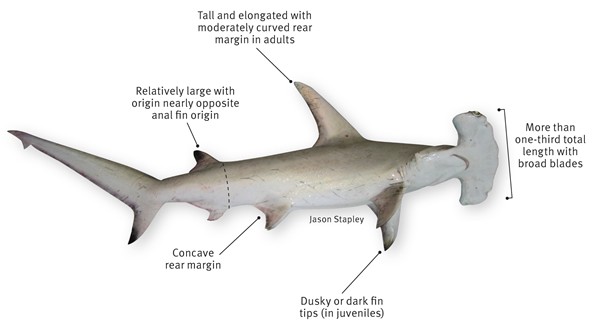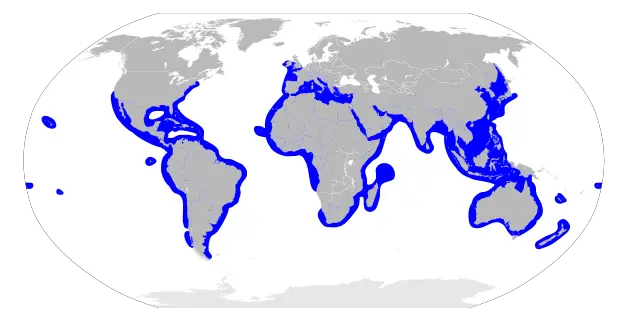Hammerhead Sharks are known for their distinctive head shape that looks like a hammer. It is due to this unique appearance which makes them interesting and create curiosity among the young minds. We have gathered complete set of Hammerhead Shark Facts For Kids that will help you in learning All About Hammerhead Sharks. You are going to learn about its scientific name, taxonomy, appearance, characteristics, size, weight, body parts, teeth, lifespan, speed, species, evolution, diet, food chain, habitat, biodiversity, migration, lifecycle, reproduction, babies, behavior, sleep, adaptations, population, endagerment, conservation and many other interesting facts about Hammerhead Sharks.
Hammerhead Shark Facts For Kids
1. What Is A Hammerhead Shark
- Hammerhead sharks are a unique and distinctive group of sharks that belongs to the family Sphyrnidae.
- They are well known for the unique and unusual structure of their heads.
- Their heads are flattened and enlarged from the sides into a hammer-like shape known as cephalofoil.
- The family of hammerhead sharks Sphyrnidae have two genera and 9 identified species.
- Eight species belong to the genus Sphyrna while Winghead shark is placed in a separate genus Eusphyra.
- Hammerhead sharks are included in the class Chondrichthyes, which means their skeleton is made up of cartilage rather than bone.
- They are found in the warm waters of continental shelves and coastlines throughout the world.
- They are carnivores and consume fish, squid, stingrays, octopus, and crustaceans, etc.

2. Hammerhead Shark Scientific Name
- The scientific names of hammerhead sharks are:
-
- Eusphyra blochii (Winghead shark)
- Sphyrna corona (Scalloped bonnethead)
- Sphyrna gilberti (Carolina hammerhead)
- Sphyrna lewini (Scalloped hammerhead)
- Sphyrna media (Scoophead)
- Sphyrna mokarran (Great hammerhead)
- Sphyrna tiburo (Bonnethead)
- Sphyrna tudes (Smalleye hammerhead)
- Sphyrna zygaena (Smooth hammerhead)
3. Hammerhead Shark Taxonomy
- The following is the scientific classification or taxonomy of hammerhead sharks:
| Kingdom | Animalia |
| Phylum | Chordata |
| Sub-phylum | Vertebrata |
| Class | Chondrichthyes |
| Order | Carcharhiniformes |
| Family | Sphyrnidae |
| Genera |
|
| Species |
|
4. Are Hammerhead Sharks Mammals
- No, hammerhead sharks are not mammals.
- They are fish and belong to the order Chondrichthyes (cartilaginous fish).
5. What Do Hammerhead Sharks Look Like – Hammerhead Sharks Description
- The known species of hammerhead sharks ranges in size from 3.0 to 19.7 feet (0.9 to 6.0 meters).
- While their body-weight ranges from 6.6 to 1,278 pounds (3 to 580 kg).
- Their skins usually have light grey color with a slightly greenish shade.
- They have white bellies which provide them camouflage and blend into the ocean when viewed from the ocean’s bottom.
- All the species of hammerhead sharks have flattened and laterally projected heads with a hammer-like appearance.
- As compared to other sharks, hammerhead sharks have very small mouths, which contain serrated teeth.
- Like other sharks, their nostrils are positioned at the tip of their head.

6. Why Do Hammerhead Sharks Have Hammerheads
- The hammer-shaped heads of the hammerhead sharks is one of the most strange creations of evolution.
- A study suggests that their heads evolved into such an odd shape probably to enhance their vision and hunting power.
- In that study, the visual fields of the three species of hammerhead sharks (winged, scalloped, and bonnethead) was compared with those of the two species of other sharks.
- The eye’s field of vision of each species was measured and then their “binocular overlap” (the overlapping portion between the two eyes of a stereoscopic vision system) was calculated.
- It was found that the species with broad hammer-heads have greater degree of overlap than those with less-wide hammer-head.
- Another possibility of having flattened and hammer-like heads is that it may boost their swimming performance.
- They can also use their hammer-like heads as a weapon. Their heads have specialized sensory organs through which they can handle prey.
7. Hammerhead Shark Characteristics
- The following are some of the major and unique characteristics of hammerhead sharks:
- They have a wide, flattened, and hammer-like head known as cephalofoil.
- They have a wide set of eyes positioned on the both sides of cephalofoil.
- Their wide, hammer-shaped heads have a highly specialized system of sensory organs, which allows them to deeply and thoroughly search the ocean for food.
- They have two dorsal fins like other sharks, a large and small.
- Unlike other sharks, hammerheads form groups during the day, which are known as ‘school’ or ‘shoal’. Sometimes, a group has more than 100 individuals.
- In the night, they are solitary hunters like other sharks.
- According to National Geographic, the hammerhead sharks can be found in the tropical warm water, however, some of their species take part in a mass migration during the summer in the search of cool waters.
8. How Big Are Hammerhead Sharks – Hammerhead Shark Size
- The body size of the known species of hammerhead sharks ranges from 3.0 to 19.7 feet (0.9 to 6.0 meter).
- The largest species, great hammerhead shark, have a maximum size of up to 20 feet (6.1 meters).
- While the smallest species, bonnethead shark, has an average size of 3.2 to 3.9 feet (0.9 to 1.2 meters).
9. How Much Does A Hammerhead Shark Weigh – Hammerhead Shark Weight
- The body weight of the known species of hammerhead sharks ranges from 3 to 500 kg (6.6 to 1,102 pounds).
- The known heaviest hammerhead specimen was a female great hammerhead with a body weight of 580 kg (1,280 pounds) caught in Florida.
- The adult individuals of the smallest hammerhead species, bonnethead, have body weight of up to 5.9 kg (13 pounds).
10. Hammerhead Shark Body Parts
- Hammerhead sharks have the following major body parts:
- A broad, flattened, hammer-like head
- Two eyes positioned at the lateral position of the head
- Nostrils located at the front of head
- Mouth at the underside of the head
- 5 gill slits at both sides located near the pectoral fins
- Two dorsal fins, the front one longer and the back one shorter
- Two pectoral fins and two pelvic fins at the lower right and left sides of the body
- An anal fin at the ventral side
- A caudal (tail) fin with elongated upper portion
Hammerhead Shark Diagram

11. How Many Teeth Do Hammerhead Sharks Have – Hammerhead Shark Teeth Facts
- Hammerhead sharks have triangular teeth, which are heavily serrated.
- The usual number of teeth in hammerheads is 76.
- On the both sides of the upper jaw is a row of 17 teeth with 2 to 3 teeth at the midline of the jaw or symphysis.
- On the lower jaw, there is a row of 16 to 17 teeth on either side and 1 to 3 teeth at the symphysis (midline of the jaw).
- The teeth of hammerheads usually have length between ¼ to ¾ inches.
- Every tooth has a smooth cutting edge, a distinct notch known as “hammerhead notch”, a convex enameloid shoulder, and a deep nutrient groove at the distal side.
12. How Long Do Hammerhead Sharks Live – Hammerhead Shark Lifespan
- The average lifespan of hammerhead sharks in the wild is 20 to 30 years.
- They live for a maximum age of up to 35 years.
13. How Fast Is A Hammerhead Shark – Hammerhead Shark Speed
- Hammerhead sharks can swim as fast as 40 km/hour (25 miles per hour).
14. Types Of Hammerhead Shark – Hammerhead Shark Species
- There are 9 known species or types of hammerhead sharks. The following is a brief description of all the 9 species:
-
Winghead shark
-
-
-
- Winghead shark is a hammerhead species, which has cephalofoil (hammer-like head) of an exceptional size.
- The width of their hammer-like head can be usually as half of their total body length. That is why they got the name “wing-head”.
- They are found in the coastal shallow waters of the central and western Indo-Pacific.
-
-
-
Scalloped bonnethead
-
-
-
- This species of hammerhead sharks is also known as mallet-head or crown shark.
- This species is rare and less-known.
- It is found in the eastern Pacific ocean.
-
Carolina hammerhead
- This species of hammerhead sharks inhabits the western Atlantic ocean.
- Very little is known about this species.
- The first specimen of Carolina hammerhead was recorded by Carter Gilbert in 1967 off the coast of Charleston, South Carolina.
-
-
- Scalloped hammerhead
-
-
- This species of hammerhead shark was originally known as Zygaena lewini.
- It is the most common species of hammerhead sharks.
- This species is found in the tropical coastal waters throughout the world.
- Scalloped hammerhead is listed as Endangered on the IUCN Red List.
-
Scoophead
- Scoophead is one of the smaller hammerhead sharks.
- It is found in the western Atlantic ocean and eastern Pacific ocean.
- Little is known about this species of hammerheads.
-
-
- Great hammerhead
-
-
- This species is the largest of all hammerhead sharks.
- It is found in the warm tropical waters of coastal areas and continental shelves throughout the world.
- Great hammerhead shark is also listed as Endangered on the IUCN Red List.
-
-
-
Bonnethead
-
-
-
- This species of hammerhead sharks is also known as shovel-head shark.
- It is the smallest species of all the hammerheads.
- Bonnethead shark is omnivore and is the only known omnivore of all the shark species.
- It is found off the coasts of America.
-
-
-
Smalleye hammerhead
-
-
-
- This species is one of the small species of hammerheads.
- It is also known as curry shark or golden hammerhead.
- Smalleye hammerheads are commonly found in the western Atlantic ocean.
- The IUCN Red List included smalleye hammerhead in the list of Vulnerable species due to its lower reproductive rate.
-
-
-
Smooth hammerhead
-
-
-
- This species of hammerhead sharks have a smooth “hammer” without an indentation like that of the other species of hammerheads. That is why it is named as a “smooth” hammerhead.
- This species prefers to live in temperate waters and is found at medium latitudes throughout the world.
- Smooth hammerhead is also listed as Vulnerable by the IUCN Red List.
-
15. Hammerhead Shark Evolution – Hammerhead Shark Evolution Timeline
- As sharks have cartilaginous skeletons rather than mineralized bones. So their skeleton often totally decomposes after their death.
- Typically, their teeth are the only thing in their bodies that do not decompose and are usually found as fossils.
- Hammerhead sharks show close relation with the carcharhinid sharks, which probably evolved during the mid of Tertiary period (a period from 66 million to 2.6 million years ago).
- DNA studies reveal that the ancestors of hammerheads probably live around 20 million years ago during the Miocene epoch.
- The evolutionary tree (or phylogenetic tree) of hammerheads based on mitochondrial DNA analysis showed that the most basal member of the hammerheads is the winghead shark.
- It is suggested that the ancestral hammerheads had a proportionally large cephalofoil or “hammer” like that of the winghead shark.
- Fossil studies also reveal that hammerhead sharks probably evolved earlier during the Paleocene epoch.
16. What Do Hammerhead Sharks Eat – Hammerhead Shark Diet
- Hammerhead sharks eat a wide range of prey, such as fish, crustaceans, squids, and octopus.
- The fish they eat are of a large variety, which also include other sharks.
- Stingrey is the most favorite diet of all the hammerheads.
- Bonnethead is also known for eating seagrass, which often make as much as half of their diet. They sometimes eat it unintentionally, however, have the ability to partially digest it.
- Great hammerhead sharks are known to sometimes engage in cannibalism and eat other great hammerheads including its own young.
Hammerhead Shark Prey
- The most common prey of hammerheads are:
- A variety of fish (including other sharks)
- Squids
- Octopus
- Crustaceans
- Stingrays
- Hake
- Dolphins
17. How Much Does A Hammerhead Shark Eat A Day
- It is unknown how much food a hammerhead shark eats a day.
- A pup (young hammerhead) needs to daily eat food equal to about 3.5% of its total body weight in order to maintain its growth.
18. How Do Hammerhead Sharks Find Their Food
- Hammerhead sharks use their oddly shaped head to find and capture prey.
- Their heads have special sensory organs, one group of which is known as the ampullae of Lorenzini. This group of sensory organs allows them to detect many things of prey including the electrical fields they created.
- By increasing the sensitivity of the ampullae, a hammerhead found its favorite food, stingrays, even though they are under the sand. As stingrey usually keep themselves buried under the sand or mud at the ocean floor.
- Hammerheads use their head to pin a stingray down, and eat it when it becomes shocked and weak.
19. Hammerhead Shark Food Chain
-
Producers
-
- In the food chain of hammerhead sharks, algae, phytoplanktons, and marine vegetations are the producers. They get energy from sunlight or other sources and prepare their food itself.
-
Primary Consumers
-
- Small crustaceans, mollusks, and most of the other small marine invertebrates consume phytoplanktons, algae, and other marine vegetation.
-
Secondary Consumers
- Shrimps, fish, crabes, squids, octopus, and stingrays, etc, consume small marine invertebrates and crustaceans.
-
Predators
- Fish species (such as hake, sharks) eat a variety of fish, squids, and crustaceans.
-
Apex Predators
-
- Hammerhead shark is the apex predator of its food chain, and prey on other fish (including sharks), rays, squids, and crustaceans, etc. They also sometimes eat other hammerhead species.
20. Where Do Hammerhead Sharks Live – Hammerhead Shark Habitat
- Hammerhead sharks are found throughout the world in the temperate and warm waters of coastlines and continental shelves.
- The following is a brief description about the habitat of all known hammerhead species:
-
Winghead shark
- Winghead shark is found in the shallow waters close to shores.
- It is known for entering into estuaries.
- It inhabits the tropical waters of the central and western Indo-Pacific.
- The habitat range of this species is from the Persian Gulf to New Guinea and extends at the north as far as Taiwan and at the south as far as Montebello Islands (off the coast of western Australia).
-
Scalloped bonnethead
- This hammerhead shark species inhabits the tropical and subtropical waters in eastern Pacific Ocean.
- Their habitat range is from Mexico to Peru.
- Scalloped bonnethead prefers to live over the inshore soft bottoms (such as sand, mud, and gravel) at the depth of 100 meters (328 feet).
- It also sometimes enters estuaries and mangroves.
-
Carolina hammerhead
- This species of hammerhead sharks inhabits the western Atlantic ocean.
- Their breeding or pupping grounds are located off the coast of South Carolina.
-
Scalloped hammerhead
- This species of hammerhead shark is found worldwide in the warm tropical waters between the latitude of 36°South to 46°North.
- They mostly live at the depth of 25 meters (82 feet), however, can be also found at the depth of 500 meters (1,600 feet).
-
Scoophead
- Scoophead inhabits the shallow inshore waters.
- It is found in the tropical waters of the eastern Pacific Ocean and western Atlantic Ocean.
- In the eastern Pacific, its habitat range is from the Gulf of Mexico to Ecuador.
- While in the western Atlantic, its range is from Panama to southern Brazil.
-
Great hammerhead
- Great hammerhead sharks live in the tropical waters between the latitude of 37°South and 40°North.
- They may be found in offshore waters of 1 meter (3.3 feet) to 80 meters (260 feet) depth.
- In the Atlantic, it occurs from North Carolina to Uruguay (including the Caribbean Sea and the Gulf of Mexico), from Morocco to Senegal, as well as in the Mediteranian Sea.
- It occurs all across the Indian Ocean’s rim.
- In the Paacific Ocean, it is found from the Japanese Ryukyu Islands to Australia, French Polynesia, and New Caledonia, as well as from Peru to southern California.
-
Bonnethead
- This hammerhead shark species is found in the regions off the coast of America where the water temperature is more than 21 ℃ (70 ℉).
- Its habitat range is from southern California to Ecuador, and from New England to the Gulf of Mexico and Brazil.
-
Smalleye hammerhead
- This species of hammerhead sharks prefer to live in the muddy habitat of shallow coastal waters with very poor visibility.
- They are commonly found in the western Atlantic Ocean.
- Their habitat range is from Venezuela to Uruguay.
-
Smooth hammerhead
- Smooth hammerhead sharks mostly prefer to live in the temperate waters.
- It is found at higher latitudes throughout the world than any other shark species.
- In the Atlantic ocean, it is found from eastern Canada to Virgin Islands, from Brazil to southern Argentina, and from the British Isles to Ivory Coast.
- In the western Pacific, it is found from the Gulf of Tonkin (off the coast of South China and Northern Vietnam) to southern Japan and the region known as Russian Far East. It also occurs off the coast of Australia and New Zealand.
- In the central and eastern parts of Pacific, smooth hammerheads are found off the coast of Hawaiian Islands, California, Panama, Equador, and Chilli.
- In the Indian Ocean, it occurs off the coast of South Africa, India, and Sirilanka.
21. What Ocean Zone Do Hammerhead Sharks Live In
- Hammerhead sharks live in the Mesopelagic Zone of the ocean.
Hammerhead Shark Habitat Map

22. Hammerhead Shark Biodiversity
- Biodiversity of hammerhead sharks means their variety or different types found in the world or a specific habitat.
- There are 9 known species of the hammerheads, which are usually found in the warm and temperate tropical waters throughout the world.
23. Why Do Hammerhead Sharks Migrate – Hammerhead Sharks Migration
- Some species of the hammerhead sharks are known to migrate during the summer months to live in cold water.
- The species that are known for migration are great hammerhead, scalloped hammerhead, bonnethead, and smooth hammerhead sharks.
- A non-profit organization known as Mision Tiburon carried out a research on scalloped hammerhead sharks. The research found the migration of adult scalloped hammerheads from the pelagic waters off shore the Cocos Island (Australia) to the fjord of Golfo Dulce (a tropical fjord on the Pacific Ocean side of Costa Rica). The females reproduced there and gave birth to living youngs. The youngs remain there for about 3 years. After that time, they left the Golfo Dulce and migrated back to the pelagic waters of Cocos Island.
- Great hammerhead sharks are also migratory. Their population in the South China Sea and off the coast of Florida have been documented for migration to the cold waters near the poles during summer.
- Bonnethead sharks migrate in large groups known as schools. In summer, they migrate towards the cold water near poles and during winter they migrate back to warmer latitudes.
- Smooth hammerhead is also migratory and travels towards the cold polar waters during summer. In winter, it migrates back towards the equator.
24. Hammerhead Shark Life Cycle – Life Cycle Of A Hammerhead Shark
- The life cycle of hammerhead sharks starts when they become sexually mature.
- The age of sexual maturity is different for species.
- They reproduce via viviparous mode of reproduction.
- The embryos develop into pups inside the mother’s body.
- Many pups are born at a time in the form of a litter (12 to 15 usually) after a gestation period of 9 to 11 months.
- Hammerhead sharks live for an average of 20 to 30 years in the wild.
25. How Does The Hammerhead Shark Reproduce – Hammerhead Shark Reproduction
- Hammerhead sharks reproduce through viviparous mode of reproduction and the females give birth to living youngs.
- They reproduce only once in a year.
- A male violently attracts the female for mating usually through biting her.
- Like other sharks, fertilization is internal in hammerhead sharks.
- In the female’s body, special yolk sacs sustain the developing embryos.
- When the supply of yolk becomes finished, the exhausted yolk sac transforms into a structure known as ‘yolk sac placenta’.
- The yolk sac placenta is analogous to the mammalian placenta, through which the mother delivers sustenance to the embryos till their birth.
- The gestation period of hammerheads usually lasts for about 9 to 11 months.
- A mother hammerhead shark gives birth to a litter consisting of 12 to 15 pups.
- The litter of great hammerhead shark species usually consist of 20 to 40 pups.
26. Hammerhead Shark Baby
- A baby hammerhead shark is known as a “pup”.
- A pup born in a litter along with many brothers and sisters (12 to 15).
- Once a pup is born, it is not taken care of by its parents.
- The newborn pup huddles together with other fellow pups of its litter and moves toward the warm waters.
- A pup eats the same diet as its adult relatives, such as fish, octopus, squids, crabes, and stingrays, etc.
- The pups are usually faster swimmers than their adults, which is necessary for their survival and to avoid predators.
27. How Dangerous Are Hammerhead Sharks – Hammerhead Shark Attack
- Hammerhead sharks are usually considered as harmless to humans because most of their species have fairly small size.
- However, the big size and fierceness of the great hammerhead shark make it possibly dangerous to humans, but there are very few recorded attacks.
- The International Shark Attack File reveals that since 1580 AD, the number of documented and unprovoked attacks of hammerhead sharks on humans is 17.
- There is no record of human casualties in their attacks.
28. Hammerhead Shark Behavior
- Hammerhead sharks show an unusual behavior of farming groups known as ‘schools”.
- A school usually has up to 500 members.
- They usually stay in schools during the daytime while staying solitary at night.
- Some hammerhead shark species migrate to the cold water of polar regions in summer. While in the winter, they migrate back to the tropical warm waters.
- Some species of the hammerheads like to live in shallow waters while some (great hammerheads) prefer to stay in deep waters.
- Hammerhead sharks are considered dangerous to humans, however, they are not aggressive. Most of the hammerhead species are of smaller size and harmless.
29. When Do Hammerhead Sharks Sleep
- It is unknown that hammerhead sharks sleep or not.
- In fact, they do not sleep like that of humans.
- It is possible that they may sleep in the form of shutting down parts of their brain to take rest.
- However, the oxygen supply to their bodies must be not interrupted and water must pass continuously through their gills.
- They also must keep swimming continuously while resting parts of their brain, otherwise they would be sunk.
30. Hammerhead Shark Adaptations
- Hammerhead sharks are well-adapted to their marine habitat. Some of their major adaptations are:
-
Hammer-shaped head
- The hammer-shaped head or cephalofoil have many special sensory systems.
- Their cephalofoil provides them the ability to detect the movements and vibrations of their prey and predators even when they are not visible.
- One group of sensory organs in their cephalofoil is known as the ampullae of Lorenzini. Along with many other things, this organ also allows them to detect the electric field created by its favorite prey (such as stingray) while buried under mud or sand.
- They also use their hammer-like head as a weapon.
-
Position of the eyes
- The eyes of hammerheads are positioned on the sides of cephalofoil.
- It allows them a 360° view in the vertical plane.
- It means they have the ability to see above and below in the ocean.
- They also have a good vision and can see in the murky waters of the ocean.
-
Large dorsal fin
- Having a large dorsal fin is another adaptation of the hammerhead sharks.
- Large dorsal fin allows the hammerheads to quickly twist and turn their bodies during swimming just like a boat’s rudder.
- When a hammerhead moves to the sides, long dorsal fins increase its wingspan and make it an efficient swimmer.
-
- Other adaptations of the hammerhead sharks are a good sense of smell, a powerful body, and sharp serrated teeth.
-
What Are The Behavioral Adaptations Of A Hammerhead Shark – Hammerhead Shark Behavioral Adaptations
- Some of the behavioral adaptations of the hammerhead sharks are:
- Grouping or making schools of up to 500 members, probably to avoid predators.
- Migration to cold waters in summer and to temperate waters in winter.
- Being excellent and aggressive hunters.
- Not aggressive towards humans, however, very defensive if provoked.
32. How Many Hammerhead Sharks Are Left – Hammerhead Sharks Population
- There is no estimation about the population of all the hammerhead shark species.
- However, the population of most of the hammerhead species is declining.
- Most of the species are in the list of the IUCN Red List of endangered, vulnerable, and near threatened species.
33. Are Hammerhead Sharks Endangered – Why Are Hammerhead Sharks Endangered
- Yes, three species of the hammerhead sharks are endangered. They are:
-
- Winghead shark
- Scalloped hammerhead
- Great hammerhead
- Major reasons of their endangerement are:
-
- Excessive hunting for fins, liver (to obtained oil for vitamins), flesh, and skin (used as a leather)
- High mortality rate (as most species have coastal habitat and unintentionally captured in the nets of large-scale fishing)
- Pollution
- Climate change
34. Hammerhead Sharks Conservation Status
- The following is the conservation status of all the known hammerhead shark species on the IUCN Red List:
| Species | Conservation Status |
| Eusphyra blochii (Winghead shark) | Endangered |
| Sphyrna corona (Scalloped bonnethead) | Near Threatened |
| Sphyrna gilberti (Carolina hammerhead) | Yet to be assessed |
| Sphyrna lewini (Scalloped hammerhead) | Endangered |
| Sphyrna media (Scoophead) | Data deficient |
| Sphyrna mokarran (Great hammerhead) | Endangered |
| Sphyrna tiburo (Bonnethead) | Least Concerned |
| Sphyrna tudes (Smalleye hammerhead) | Vulnerable |
| Sphyrna zygaena (Smooth hammerhead) | Vulnerable |
35. What Eats Hammerhead Sharks – Hammerhead Sharks Predator
- Killer whale or Orca is the only natural predator of the hammerhead species. Killer whales prey on all the species of hammerheads of any age.
- Other large shark species, such as bull sharks and great white sharks, prey on the juvenile hammerheads.
What Sharks Do Hammerhead Sharks Eat
- Hammerhead sharks eat grey reef shark, blacktip reef shark, other species of the hammerhead sharks, and other small shark species.
- Great hammerhead shark is also known for cannibalism and sometimes eats individuals of its own species.
36. Is Hammerhead Shark Edible
- Yes, hammerhead sharks are edible and humans often eat their meat.
- The fins of smooth hammerheads are used in shark fin soup.
- Consumers of the hammerhead sharks must be aware that the meat of large specimens possibly have a higher level of mercury and other pollutants, which may be dangerous for health.
37. Hammerhead Shark Fun Facts – Interesting Facts About Hammerhead Sharks
- Hammerhead sharks are skilled predators. Their unusual heads have many specialized sensory systems, which improve their ability of finding prey.
- Hammerhead sharks have eyes on the sides of their hammer (cephalofoil). It allows them a 360° view in the vertical plane, which means they can simultaneously see things above and below them in the ocean.
- Due to the unique shape of their head and the position of their eyes, hammerheads have an excellent sense of vision than all the other shark species.
- Hammerheads are well-known for their agility and have the ability to quickly twist and turn their bodies.
- Stingray is the favorite prey of hammerhead sharks. Hammerheads find out buried stingrays by detecting their electric fields.
- Bonnethead (Sphyrna tiburo) is the only hammerhead shark species as well as the only shark species known for eating seagrasses and seaweeds as a major part of its diet.
- The Great hammerhead is the largest of all the hammerhead shark species. It uses its head as a weapon to pin down stingrays.
- Winghead shark (Eusphyra blochii) species has the widest head of all the hammerheads. Its head can be as wide as half of its total body length.





